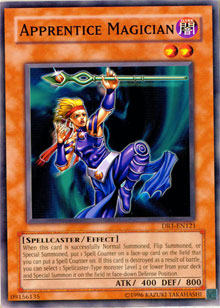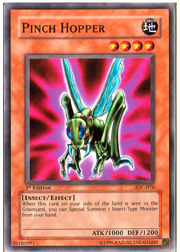We’ll begin with a brief follow-up for mandatory trigger effects, and then we’ll move on to optional trigger effects.

Maybe I Shouldn’t Activate . . . But I’m Doing It Anyway
Example 1: Surprising the Apprentice
Player A has no cards on his side of the field and his opponent has only one set spell or trap card. Player A normal summons
Apprentice Magician. The Magician’s mandatory trigger effect activates, even though he does not have a target for his effect. Player A’s opponent can activate her set
Pulling the Rug card to negate
Apprentice Magician’s effect.
Example 2: Lord Poison is all alone
Player A has no cards in his graveyard when Player B destroys his Lord Poison in battle. Lord Poison is sent to the graveyard and its effect activates, even though there are no Plant-type monsters in his graveyard that he can special summon.
Optional Trigger Effects
Unlike mandatory trigger effects, optional trigger effects are never forced upon you. You always have the option to say, "I don’t want to activate this effect," and doing so prevents the effect from activating at all. Selecting to activate the optional trigger effect can be difficult, because they are very picky.
Optional trigger effects look for a specific event, like mandatory trigger effects, but they can only be activated at the time the event occurs. If anything interferes and prevents you from activating the effect, you lose your chance. You cannot simply activate the effect at a later time. Some actions shouldn’t be taken with cards that have optional trigger effects because they will always result in losing the effect—something we refer to as "missing the timing."
 Clinching the Timing
Clinching the Timing So when can we activate optional trigger effects? I don’t have any easy answers for you, because it really depends on the event the effect is looking for. We will have plenty of examples later to explain this, so let’s focus on some general optional trigger effects first.
Events that have a variation of "when a monster is summoned, you can . . ." or "when this monster is summoned, you can . . ." will work just fine when a monster is normal summoned or flip summoned without having to use a card effect. When I begin my main phase and normal summon my Manju of the Ten Thousand Hands, I am given the chance to activate its effect. If I activate the effect, my opponent can chain a card that responds to the summon (Trap Hole, etc.), an effect that negates Manju’s effect (Skill Drain, etc.), or any other spell speed 2 or higher effect with appropriate timing.
When it comes to tribute summons, you usually don’t have a problem if the card with the optional trigger effect is the monster being tribute summoned, or if your card has an effect that activates because a monster is tribute summoned. For example, when I tribute summon Des Frog, I can activate its effect to special summon additional copies of Des Frog or pass and not activate its effect.
Certain game actions that don’t require use of the chain also tend to work well with optional trigger effects. When a monster declares an attack, changes its battle position manually, or is special summoned with its own "inherent" special summon (Cyber Dragon, Gladiator Beast Heraklinos, etc.), you can activate optional trigger effects that look for these events.
Optional trigger effects looking for an event that occurs when a chain resolves are the pickiest by far. The event must occur when the effect at chain link 1 resolves. Usually it must be the very last thing that happens when the effect at chain link 1 resolves. Some effects will perform several actions when they are resolved, and the one that matters most is the last action performed.
The following examples demonstrate an optional trigger effect that can be activated when the chain resolves:
Tributing and Paying Costs
As I mentioned previously, there are some things you just don’t want to do with cards that have optional trigger effects because it never works in your favor.
The first issue (and a fairly common one at that) is tributing or otherwise sending a monster with an optional trigger effect to the graveyard for the summon of a different monster, or to activate an effect. Monsters that fall into this category tend to have text that says something similar to "when this card is sent from the field to the graveyard, you can . . ." Tributing Pinch Hopper or Poison Draw Frog to summon a high-level monster may get you a stronger  monster in play, but it won’t give you the effects of the Frog or Hopper. Likewise, sending them to the graveyard to pay the activation cost of a spell, trap, or monster card effect also fails.
monster in play, but it won’t give you the effects of the Frog or Hopper. Likewise, sending them to the graveyard to pay the activation cost of a spell, trap, or monster card effect also fails.
When you tribute
Pinch Hopper to tribute summon a monster, you can’t activate its effect because your only chance to do so is interrupted by the summon. If you want to activate
Pinch Hopper’s effect, you must activate it when you place it into the graveyard, but you can’t because this action is immediately followed by the summon of the high level monster and you cannot interrupt this process with effect activations. One seldom-used exception is tributing the monster to pay the cost for declaring an attack, with cards like
Panther Warrior or
Insect Queen. Since this tribute is only a cost to declare the attack and no immediate actions follow, you can activate the optional trigger effect of
Pinch Hopper when it is tributed for this purpose. If your opponent wants to activate
Sakuretsu Armor in response to the attack, he or she will do so by chaining to
Pinch Hopper’s effect.
Example: Insect Queen AttacksPlayer A declares an attack with
Insect Queen and tributes
Pinch Hopper to pay the cost. Player A can activate
Pinch Hopper’s effect, starting a chain. If Player A’s opponent wants to activate
Sakuretsu Armor in response to the attack, it will be chained to
Pinch Hopper’s effect.
When you use a monster with an optional trigger effect to pay the cost to activate an effect, you have a different problem. When you tribute a monster with a mandatory trigger effect, it will want to activate but cannot yet do so. It must wait until the current chain resolves and then begin another chain. Optional trigger effects must be activated immediately when their event occurs or they cannot be activated at all. Since it isn’t possible to activate them at this time, you are forced to pass on the effect. You don’t get the luxury of waiting until the chain finishes resolving and then starting another chain, like you do with mandatory trigger effects.
The most important things to remember:
1 - If you tribute your optional trigger effect monster for a tribute summon, its optional trigger effect cannot activate.
2 - If you use your optional trigger effect monster to pay the cost to activate an effect, its optional trigger effect cannot activate.
Next week we will continue our look at optional trigger effects and also look at what happens when mandatory and optional trigger effects want to activate at the same time. Until next time, send all comments and questions to Curtis@Metagame.com.